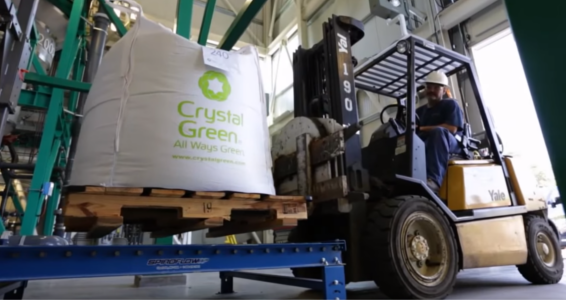Two new industrial facilities that will bring the circular economy one step closer were officially opened in Europe on Friday: a carbon dioxide-based chemical plant in Germany and a nutrient recovery facility in the Netherlands. The transition from a linear take-make-waste economy to one which keeps materials ‘circulating’ for as long as possible (or, ideally, indefinitely) has been an international priority in the continent. The European Commission released its Circular Economy Package late last year and is even offeringfinancial incentives to “help risk-takers make the leap.”
European Chemical Industry Council (Cefic) member Covestro launched a new production plant in Dormagen, near Cologne, Germany that replaces crude oil with carbon dioxide to manufacture a new type of polyol as a building block of polyurethane foam – a versatile material that is used in many industries around the world. The new process replaces the traditional oil-based raw material with CO2, which makes up about 20 percent of the foam component. The CO2 is chemically-bound into the material. Initially, the foam is intended for use in mattresses and upholstered furniture; its quality achieves at least the same high standards as the conventional petrochemical-based material and no additional energy needs to be expended in its production.
“We have to change the way we look at CO2, and we will. Using it as an alternative source of raw materials is a solution to some of the biggest challenges of our time – finding a replacement for finite fossil resources such as oil and gas and closing material cycles,” Covestro CEO Patrick Thomas said at the opening ceremony. “Thanks to our innovative process and the launch of our production operations in Dormagen, we see ourselves as a pioneer in this area – true to our vision ‘To make the world a brighter place.’”
Covestro scientists worked hand-in-hand with experts from the CAT Catalytic Center in Aachen – a research institute operated jointly with RWTH Aachen University – to find the right catalyst that would make the chemical reaction with CO2 possible. The company has invested some €15 million in the new plant, which has an annual production capacity of 5,000 metric tons. The CO2 used is a waste product from a neighboring chemical company.
“Making efficient use of the carbon dioxide molecule, which is normally slow to react, is a real scientific and technical challenge. We have made a breakthrough by combining application-centric basic research with research-based industrial practices,” said Professor Ernst Schmachtenberg of RWTH.
“This method of using carbon dioxide as a raw material is an important step as we move toward a sustainable future. The German Federal government is promoting the use of CO2 as a raw material in order to expand the chemical industry’s raw materials basis and open new avenues to sustainability,” added Thomas Rachel, Parliamentary State Secretary from the German Federal Ministry of Education and Research. The Ministry supported Covestro’s technology financially in the research and development phase.
In addition to flexible foam, Covestro is working to manufacture many other plastics using CO2.
In addition to flexible foam, Covestro is working to manufacture many other plastics using CO2. Previously, Ford has used soy-based polyurethane foam and California-based companies have developed plant-based polyurethane for use on floors, furniture and in foam insulation.
Meanwhile in the Netherlands, the Dutch Waterboard Vallei & Veluwe (The Waterboard) opened Europe’s first commercial nutrient recovery facility, in partnership with Eliquo Water & Energy and Vancouver, Canada-based Ostara Nutrient Recovery Technologies.
The new facility is part of The Waterboard’s transformation of its Amersfoort Wastewater Treatment Plant (WWTP) into an Energy and Nutrient Recovery Factory, supported by the European Union’s LIFE+ subsidy program. The Factory features, amongst others, Ostara’s Pearl® nutrient recovery and WASSTRIP® technologies, where phosphorous and nitrogen are recovered to create a high value fertiliser product from an existing resource with a process that is both environmentally and economically viable. Eliquo designed and constructed the facility, which also uses the Dutch company’sLysoTherm® waste-activated sludge (WAS) disintegration system.
Seven sewage treatment plants have previously been converted into “energy and nutrient facilities” in the Netherlands, but this is the first facility to produce a “ready to use” fertiliser product, sold as Crystal Green®. It has the capacity to produce approximately 900 metric tons of the product each year. The Waterboard will earn revenue for every ton of fertilizer it produces on top of the annual cost savings in chemicals, solid waste disposal, maintenance and power.
“The key difference with the Amersfoort facility launched today is that a high value, ready-for-sale fertiliser product is being produced, ready for use on agricultural crops and in the turf and horticulture markets,” said Tanja Klip-Martin, Principal at The Waterboard.
“[The Dutch Waterboard and Eliquo’s] efforts have allowed us to create a sustainable phosphorous fertiliser that will be produced locally and sold in the Netherlands, as the highest beneficial reuse of an existing resource,” added Phillip Abrary of Ostara.
The facility is designed to treat more than 8,000m3 of water each day and also acts as a regional sludge-processing hub for a number of WWTPs and imports approximately 40 percent of sludge from other locations. Approximately 12,000 metric tons of dry sludge is treated annually at the new facility; the digestion is enhanced with LysoTherm in order to increase biogas and related energy production. s a result, the new facility will produce enough energy to treat all the wastewater from the City of Amersfoort, as well as a surplus, enough to provide 600 households with green electricity during the year.

